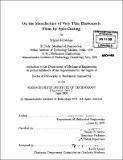| dc.contributor.advisor | Sanjay E. Sarma. | en_US |
| dc.contributor.author | Krishnan, Sriram, 1978 May- | en_US |
| dc.contributor.other | Massachusetts Institute of Technology. Dept. of Mechanical Engineering. | en_US |
| dc.date.accessioned | 2008-09-03T15:14:23Z | |
| dc.date.available | 2008-09-03T15:14:23Z | |
| dc.date.copyright | 2007 | en_US |
| dc.date.issued | 2007 | en_US |
| dc.identifier.uri | http://hdl.handle.net/1721.1/42291 | |
| dc.description | Thesis (Ph. D.)--Massachusetts Institute of Technology, Dept. of Mechanical Engineering, 2007. | en_US |
| dc.description | Includes bibliographical references (p. [167]-172). | en_US |
| dc.description.abstract | I present a process for manufacturing poly-dimethylsiloxane (PDMS) films of thicknesses down to 50 microns. PDMS films are currently fabricated by spin-coating the polymer on a wafer and then manually peeling the film after curing. This is labor-intensive and suffers from low yield, dimensional inaccuracies, tearing and wrinkling. I apply manufacturing principles to the preparation of PDMS to enable more accurate, efficient, and reliable manufacturing. Difficulties in the preparation of PDMS films occur for two reasons: a) the material properties of PDMS are hard to characterize and b) process steps are hard to characterize. In analyzing the functional steps in PDMS manufacture, I first examine the spin-coating process. There has been surprisingly little work on thickness control, and I show how unlike with photoresist, the thickness of the coat can be controlled quite robustly by a judicious choice of process parameters. I also show how second-order variations can be controlled by using an inexpensive interferometric technique developed by our collaborators. I then analyze the physics of peeling and show why initiation, beading and tearing are difficult issues. Furthermore the line of separation of between the film and the wafer is difficult to advance without dynamic effects and micro-slippage. In order to prevent these problems, I introduce two new process concepts. First, I introduce a thin 'scaffold', incorporated in situ between the PDMS film and the substrate during spin-coating, which can start the peel front, eliminate the bead, as well as support the film as it is peeled. I then introduce the use of an adhesive roller actuator with a compressive pre-load which helps peel the film while controlling the peel-front. I show how, by using a ferro-magnetic material, the scaffold can be separated and handled by magnetic attachment. I show how the scaffolding can also incorporate a kinematic coupling for subsequent registration in layering. Finally, I will present experimental results showing thickness metrology, model verification and peeling success. | en_US |
| dc.description.statementofresponsibility | by Sriram Krishnan. | en_US |
| dc.format.extent | 172 p. | en_US |
| dc.language.iso | eng | en_US |
| dc.publisher | Massachusetts Institute of Technology | en_US |
| dc.rights | M.I.T. theses are protected by
copyright. They may be viewed from this source for any purpose, but
reproduction or distribution in any format is prohibited without written
permission. See provided URL for inquiries about permission. | en_US |
| dc.rights.uri | http://dspace.mit.edu/handle/1721.1/7582 | en_US |
| dc.subject | Mechanical Engineering. | en_US |
| dc.title | On the manufacture of very thin elastomeric films by spin-coating | en_US |
| dc.type | Thesis | en_US |
| dc.description.degree | Ph.D. | en_US |
| dc.contributor.department | Massachusetts Institute of Technology. Department of Mechanical Engineering | |
| dc.identifier.oclc | 232357466 | en_US |
